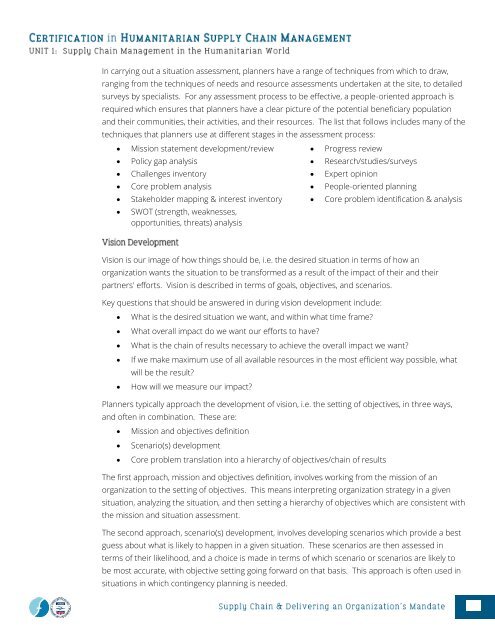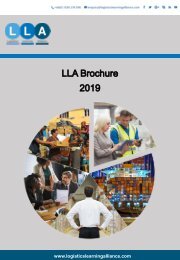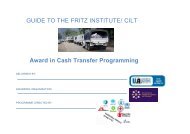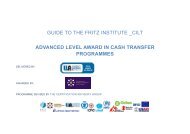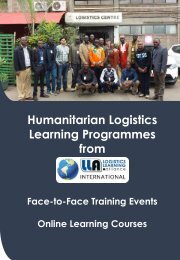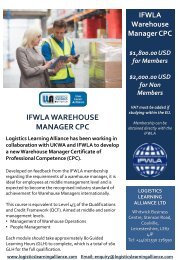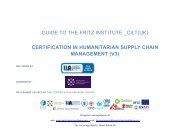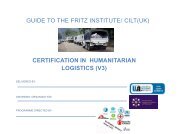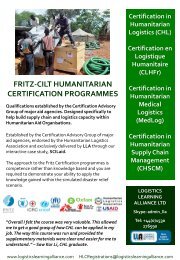CHSCM 3.0 - Unit 1 - SCM in the Humanitarian World
Learning Materials for Unit 1 of the Certification in Humanitarian Supply Chain Management (CHSCM).
Learning Materials for Unit 1 of the Certification in Humanitarian Supply Chain Management (CHSCM).
Create successful ePaper yourself
Turn your PDF publications into a flip-book with our unique Google optimized e-Paper software.
In carry<strong>in</strong>g out a situation assessment, planners have a range of techniques from which to draw,<br />
rang<strong>in</strong>g from <strong>the</strong> techniques of needs and resource assessments undertaken at <strong>the</strong> site, to detailed<br />
surveys by specialists. For any assessment process to be effective, a people-oriented approach is<br />
required which ensures that planners have a clear picture of <strong>the</strong> potential beneficiary population<br />
and <strong>the</strong>ir communities, <strong>the</strong>ir activities, and <strong>the</strong>ir resources. The list that follows <strong>in</strong>cludes many of <strong>the</strong><br />
techniques that planners use at different stages <strong>in</strong> <strong>the</strong> assessment process:<br />
• Mission statement development/review<br />
• Policy gap analysis<br />
• Challenges <strong>in</strong>ventory<br />
• Core problem analysis<br />
• Stakeholder mapp<strong>in</strong>g & <strong>in</strong>terest <strong>in</strong>ventory<br />
• SWOT (strength, weaknesses,<br />
opportunities, threats) analysis<br />
• Progress review<br />
• Research/studies/surveys<br />
• Expert op<strong>in</strong>ion<br />
• People-oriented plann<strong>in</strong>g<br />
• Core problem identification & analysis<br />
Vision is our image of how th<strong>in</strong>gs should be, i.e. <strong>the</strong> desired situation <strong>in</strong> terms of how an<br />
organization wants <strong>the</strong> situation to be transformed as a result of <strong>the</strong> impact of <strong>the</strong>ir and <strong>the</strong>ir<br />
partners' efforts. Vision is described <strong>in</strong> terms of goals, objectives, and scenarios.<br />
Key questions that should be answered <strong>in</strong> dur<strong>in</strong>g vision development <strong>in</strong>clude:<br />
• What is <strong>the</strong> desired situation we want, and with<strong>in</strong> what time frame?<br />
• What overall impact do we want our efforts to have?<br />
• What is <strong>the</strong> cha<strong>in</strong> of results necessary to achieve <strong>the</strong> overall impact we want?<br />
• If we make maximum use of all available resources <strong>in</strong> <strong>the</strong> most efficient way possible, what<br />
will be <strong>the</strong> result?<br />
• How will we measure our impact?<br />
Planners typically approach <strong>the</strong> development of vision, i.e. <strong>the</strong> sett<strong>in</strong>g of objectives, <strong>in</strong> three ways,<br />
and often <strong>in</strong> comb<strong>in</strong>ation. These are:<br />
• Mission and objectives def<strong>in</strong>ition<br />
• Scenario(s) development<br />
• Core problem translation <strong>in</strong>to a hierarchy of objectives/cha<strong>in</strong> of results<br />
The first approach, mission and objectives def<strong>in</strong>ition, <strong>in</strong>volves work<strong>in</strong>g from <strong>the</strong> mission of an<br />
organization to <strong>the</strong> sett<strong>in</strong>g of objectives. This means <strong>in</strong>terpret<strong>in</strong>g organization strategy <strong>in</strong> a given<br />
situation, analyz<strong>in</strong>g <strong>the</strong> situation, and <strong>the</strong>n sett<strong>in</strong>g a hierarchy of objectives which are consistent with<br />
<strong>the</strong> mission and situation assessment.<br />
The second approach, scenario(s) development, <strong>in</strong>volves develop<strong>in</strong>g scenarios which provide a best<br />
guess about what is likely to happen <strong>in</strong> a given situation. These scenarios are <strong>the</strong>n assessed <strong>in</strong><br />
terms of <strong>the</strong>ir likelihood, and a choice is made <strong>in</strong> terms of which scenario or scenarios are likely to<br />
be most accurate, with objective sett<strong>in</strong>g go<strong>in</strong>g forward on that basis. This approach is often used <strong>in</strong><br />
situations <strong>in</strong> which cont<strong>in</strong>gency plann<strong>in</strong>g is needed.


